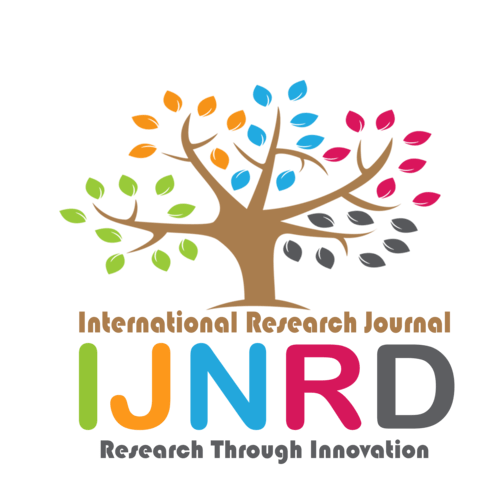|
|||||||||||||||

|
INTERNATIONAL JOURNAL OF NOVEL RESEARCH AND DEVELOPMENT International Peer Reviewed & Refereed Journals, Open Access Journal ISSN Approved Journal No: 2456-4184 | Impact factor: 8.76 | ESTD Year: 2016 Scholarly open access journals, Peer-reviewed, and Refereed Journals, Impact factor 8.76 (Calculate by google scholar and Semantic Scholar | AI-Powered Research Tool) , Multidisciplinary, Monthly, Indexing in all major database & Metadata, Citation Generator, Digital Object Identifier(DOI) |
||||||||||||||
Issue: April 2024
Volume 9 | Issue 4
Review Result and Publication of Paper within : 2-3 days
Click Here For more DetailsFor Authors
Forms / Download
Published Issue Details
Editorial Board
Other IMP Links
Facts & Figure
Impact Factor : 8.76
Issue per Year : 12
Volume Published : 9
Issue Published : 95
Article Submitted :
Article Published :
Total Authors :
Total Reviewer :
Total Countries :
Indexing Partner
Join RMS/Earn 300
Licence
This work is licensed under a Creative Commons Attribution-NonCommercial 4.0 International License







|
Published Paper Details
|
|
| Paper Title: | Effectiveness of music therapy on certain bio-psychological parameters among mechanically ventilated patients admitted in Vinayaka Missions Hospital, Salem, Tamilnadu. |
| Authors Name: | J.Vinodhini Zipporah |
| Download E-Certificate: | Download |
| Author Reg. ID: |
IJNRD_199479
|
| Published Paper Id: | IJNRD2306337 |
| Published In: | Volume 8 Issue 6, June-2023 |
| DOI: | |
| Abstract: | Effectiveness of music therapy on certain bio-psychological parameters among mechanically ventilated patients admitted in Vinayaka Missions Hospital, Salem, Tamilnadu. Author: Ms.Vinodhini.J M.sc (N) Assistant Professor CSI Jeyaraj Annapackiam College of Nursing,Madurai Music is a higher revelation than all wisdom and philosophy. Music is the electrical soil in which the spirit lives, invents and thinks. -Ludwig Van Beethoven. In mechanically ventilated patients there are stressors including physiological signs of sympathetic nervous system activation and psychological distress that necessitates treatment with pharmacological agents. A wide range of medical conditions combined with exposure to the unique environmental circumstances of the intensive care unit elicit problematic patient behavior patterns requiring the application of physical and/or use of chemical restraints. Moreover mechanically ventilated patients often experience adverse events, including construction of arteries and construction of airways in the lungs caused by the anxiety. (Mary Kathleen Wilkins, Margery L Moore ) Increased anxiety in turn may lead to behavioral pattern changes and delays process of liberating the patient from mechanical support. An increase in morbidity and mortality in anxious critically ill patients has been found. (Boles, Lindgren ) Therefore analgesia and sedation are considered important in the management of patients who require mechanical ventilation. There are serious complications because of sedative agents too. Sedation may contribute to venous thrombosis or pressure damage to the nerves and skin. Immune responses may be weakened from extreme use of sedative medications. (Suter ). Music can actively integrate mind and body, affecting emotional response, movement and sensory input. This results in the modification of neurological pathways in the brain facilitating changes in behavior. Thus music therapy has been proven to improve respiration, lower blood pressure, improve cardiac output, reduce heart rate and relax muscle. (Good.M, J.C. Anderson et al ) The effectiveness of music therapy as a non pharmacologic intervention in the reduction of pain, anxiety, and increased feeling of control and well-being has been demonstrated in mechanically ventilated patients. (Chlan; Wong et al., ) Interventions to promote comfort can be implemented by the nurses without a physicians order. One such intervention can be the use of music therapy in the population of mechanically ventilated patients. (McCaffrey & Locsin ) OBJECTIVES 1. To assess certain bio-psychological parameters among mechanically ventilated patients in experimental and control group before and after music therapy. 2. To compare the effectiveness of music therapy on certain bio-psychological parameters among mechanically ventilated patients in experimental group and control group. 3. To find out the association between the post test scores on mechanically ventilated patients in experimental group with their demographic variables. DELIMITATIONS The study was delimited to, • Assess the effectiveness of music therapy. • Identify changes in certain bio-psychological parameters. • Mechanically ventilated patients. • Vinayaka Mission Hi-Tech hospital, Salem. CONCEPTUAL FRAME WORK The conceptual model selected for this study is based Orem’s General Theory of Nursing. According to Orem, nursing has its special concern for the individuals need on self care action and the provision of it in on a continuous basis in order to sustain life and health, recover from disease or injury and cope with their effects. RESEARCH METHODOLOGY The research design selected for the present study was a Quasi-experimental design- Non equivalent control group pre and post test design. The study was conducted in VINAYAKA MISSION Hi-Tech HOSPITAL and Medical college hospital. Purposive sampling technique was selected for the present study. The total sample size selected for this study was 30 patients. 20 patients in experimental and 10 patients in control group were selected. Inclusion criteria: Mechanically ventilated patients with 1. Conditions such as Respiratory disorders Cardiac disorders Poisoning patients CNS disorders Metabolic problems Trauma cases 2. Both male and female and who are present during the study. 3. Age above 16 yrs. Exclusion criteria Mechanically ventilated patients with Brain death. Seriously ill with that of high dosages of ionotropes. Neuromuscular blockades. Hearing impairment. Tool for data collection: Section A: It consists of demographic characteristics of patients in mechanically ventilated patients, i.e; Age Gender Diagnosis Type of intubation Mode of ventilation SECTION B: This consists of modified behavior assessment tool. It consists of 6 areas; they are respiratory drive, response to ventilation, coughing, best response to stimulation, tolerance to care and consolability. Each area consists of 4 options, in which score 1 is given to the patients who are self regulating with the condition whereas score 4 to the one who are unable to console. SECTION C: This consists of faces anxiety scale to assess the anxiety of the mechanically ventilated patients. This scale consists of 5 faces; each one is described as least, mild, moderate, severe and extreme anxiety. The least anxiety is given score1 and the extreme anxiety as score 5. Interpretation: 1st face- least anxiety. 2nd face- mild anxiety 3rd face- moderate anxiety 4th face – severe anxiety 5th face- extreme anxiety SECTION D: This consists of vital parameters assessment scale. It consists of 4 vital parameters; they are systolic pressure, diastolic pressure, heart rate and respiratory rate. In this score 1 is given to the least level and score 4 is given to the highest levels. DATA COLLECTION PROCEDURE Pre test: Pre test was conducted by using the modified behavior assessment tool, faces anxiety scale and vital parameters assessment scale. In a day an average of 4 patients were assessed. The time for assessment varied from 20-30 minutes. Implementation of Music Therapy Immediately after pre test music therapy was given for the experimental group patients for about 30 minutes per session and was given for two times a day for 5 days. Evaluation of Music Therapy Observation was made after 5th day of music therapy by using behavior assessment tool and faces anxiety scale. Vital parameters were checked everyday evening after the intervention. MAJOR FINDINGS The findings are summarized as below; I. To assess certain bio-psychological parameters among mechanically ventilated patients in experimental and control group before and after music therapy. In experimental group, In behavior parameter 100% of mechanically ventilated patients were found to be unable to console in pre test, whereas in post test 70% of them self regulated with the situation. In faces anxiety scale 100% of the patients were under the category of potential cause for concern in pre test and 100% of them had mild anxiety in post test. In vital parameters scale 100% of them had moderate level of vital parameters in pre test whereas in post test 50% of them had normal and moderate levels respectively. In control group, In behavior parameter 100% of patients were found to be unable to console in pre test whereas in post test 90% of patients were found to be able to console but distressed. In faces anxiety scale pre test showed that 100% of patients were under the category of potential cause for concern and the same results were found in post test also. In vital parameters scale in pre and post test 50% of them had moderate and unchanged vital parameters respectively. II.To compare the effectiveness of music therapy on certain bio-psychological parameters among mechanically ventilated patients in experimental and control group. a) Paired t test value of experimental group pre and post test scores. • The calculated Paired‘t’ value for behavior parameters and faces anxiety scale was 29.76 for experimental group at the level of significance (P) = 0.05. • The calculated paired ‘t’ value for vital parameters in experimental group pre and post test scores shows that it is 22.35 at the level of significance (P) = 0.05 b) Area wise comparison of experimental group pre and post test scores • The overall mean percentage of behavior parameters and faces anxiety scale the pre test score was 82.4% and post test score was 32.5% and the mean difference was 49.9%. • The overall mean percentage of vital parameters reveals that the pre test score was 56.25% and the post test score was 35% and the mean percentage difference was 21.25%. c) Area wise comparison of control group pre and post test scores • The overall area wise comparison mean score for behavior parameters and faces anxiety scale was 80.3% in the pre test and the post test score was 64.8% and the mean difference was 15.5%. • The overall mean score for vital parameters was 66.25% in pre test whereas in post test it was 68%. The mean difference was 1.75%. d) Unpaired t test value of experimental and control group post test scores. • The calculated unpaired ‘t’ value for the post test scores of experimental and control group on behavior parameters and anxiety was 12.95 at the level of significance (P) = 0.05. • The unpaired ‘t’ value for the post test scores of experimental and control group on vital parameters was 15.96 at the level of significance (P) = 0.05. e) Area wise comparison of control and experimental groups post test scores • The overall area wise comparison between control and experimental groups post test scores of behavior parameters and faces anxiety scale shows a mean difference score of 32.3%. The overall mean score difference for vital parameters was 33%. III. To find out the association between the demographic variables and the post test scores of experimental group regarding bio-psychological parameters among mechanically ventilated patients. The chi-square values were lesser than the table values at the level of significance P=0.05 for the post test scores of experimental group when compared with their demographic variables i.e. age, gender, diagnosis, type of intubation and mode of ventilation. NURSING IMPLICATIONS Some of the implications from the present study in various areas as follows: Nursing practice Nurses can enroll music therapy as a simple nursing intervention to promote the well being and to prevent the adverse complications of the sedative agents in mechanically ventilated patients. Nurses can utilize music therapy as an integral part of their routine care to regulate the condition of the mechanically ventilated patients. Nursing education Nurse education on music therapy can be emphasized through conferences, workshops and seminars, which can be held for nurses to impart knowledge on music therapy as a nursing intervention. Nursing research This study is a preliminary set up for exploring the concept of music therapy on certain bio psychological parameters among mechanically ventilated patients. The result of this study encourages the nurses to adopt this as a part of their nursing interventions in providing a holistic care to their patients. CONCLUSION: “I’ve learned that people will forget what you said, people will forget what you did, but people will never forget how you made them feel.” Poet Maya Angelou The researcher learned the indeed importance of music therapy for mechanically ventilated patients to make them feel consoled by that of the awesome music therapy. REFERENCES Davis WB, Gfeller KE, Thaut MH. “An Introduction to Music Therapy”. 2nd edition. McGraw-Hill, Boston. . Brenda G Bare , ‘‘Medical Surgical Nursing’’,(9th edition), Lippincott company; Philadelphia. Gaynor . The Healing Power of Sound. Shambhala Publications, Inc,Boston, MA. Wigram T, Pedersen IN, Bonde LO. A Comprehensive Guide to Music Therapy: Theory, Clinical Practice, Research and Training. Jessica Kingsley Publications, London. Aldrige, D. (ed) . Music therapy and neurological rehabilitation. Performing health. ,10: 1-84310-302-8 Bodner M, Muftuler LT, Nalcioglu O, Shaw GL , “Mozart effect: brain areas involved in spatial-temporal reasoning”. Neurology journal; 23: 683-690. Boldt, S. “The effects of music therapy on motivation, psychological well-being, physical comfort, and exercise endurance of bone marrow transplant patients.” Journal of Music Therapy, 33, 164-88. |
| Keywords: | Music therapy, mechanical ventilation, anxiety |
| Cite Article: | "Effectiveness of music therapy on certain bio-psychological parameters among mechanically ventilated patients admitted in Vinayaka Missions Hospital, Salem, Tamilnadu.", International Journal of Novel Research and Development (www.ijnrd.org), ISSN:2456-4184, Vol.8, Issue 6, page no.d380-d390, June-2023, Available :http://www.ijnrd.org/papers/IJNRD2306337.pdf |
| Downloads: | 000118750 |
| ISSN: |
2456-4184 | IMPACT FACTOR: 8.76 Calculated By Google Scholar| ESTD YEAR: 2016 An International Scholarly Open Access Journal, Peer-Reviewed, Refereed Journal Impact Factor 8.76 Calculate by Google Scholar and Semantic Scholar | AI-Powered Research Tool, Multidisciplinary, Monthly, Multilanguage Journal Indexing in All Major Database & Metadata, Citation Generator |
| Publication Details: |
Published Paper ID:IJNRD2306337 Registration ID: 199479 Published In: Volume 8 Issue 6, June-2023 DOI (Digital Object Identifier): Page No: d380-d390 Country: MADURAI, Tamil Nadu, India Research Area: Medical Science Publisher : IJ Publication Published Paper URL : https://www.ijnrd.org/viewpaperforall?paper=IJNRD2306337 Published Paper PDF: https://www.ijnrd.org/papers/IJNRD2306337 |
| Share Article: | |
|
Click Here to Download This Article |
|
| Article Preview | |
|
|
|
Major Indexing from www.ijnrd.org
| Semantic Scholar | Microsaoft Academic | ORCID | Zenodo |
| Google Scholar | ResearcherID Thomson Reuters | Mendeley : reference manager | Academia.edu |
| arXiv.org : cornell university library | Research Gate | CiteSeerX | PUBLON |
| DRJI | SSRN | Scribd | DocStoc |
ISSN Details
 |
 |
ISSN: 2456-4184
Impact Factor: 8.76 and ISSN APPROVED
Journal Starting Year (ESTD) : 2016
DOI (A digital object identifier)
Conference
Open Access License Policy
Important Details
Social Media
| Copyright © 2024 - All Rights Reserved - IJNRD |












Facebook Twitter Instagram LinkedIn